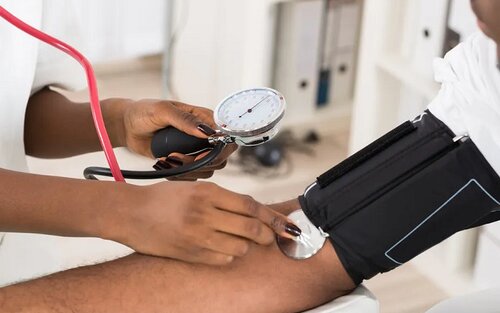High blood pressure (hypertension) - painless, but highly dangerous
In Uganda, around 26.4% of the population is affected by high blood pressure (or hypertension). And of those who know about their high blood pressure, only about 7.7% are in treatment - and in turn around 50% of those are not getting good treatment. This is a serious problem, as high blood pressure can lead to serious health problems such as heart disease, stroke, and kidney failure if it is not properly managed.

It is very important to know your blood pressure and to treat potential hypertension as early as possible.
Early monitoring is important
Cardiologists agree that from the age of 20, everyone should know their blood pressure. If it is normal, then a check every five years thereafter is advisable. The statistical probability for the occurrence of high blood pressure corresponds somewhat to age. Roughly half of 50 year olds, and around 80 percent of 80 year olds are affected by hypertension. For younger people this rule doesn't quite work - for them the risk tends to be lower. However, in the case of high familial risk -- for example when one's father suffered from high blood pressure early or had a heart attack already at age 40 -- it is necessary to assess from the blood pressure and cholesterol levels of offspring from youth, and if not -- as is often the case -- then at least by the fifth decade of life.
Hypertension is usually asymptomatic
Of the biggest pitfalls of hypertension is that it often goes unnoticed. Most hypertension patients have no symptoms at all -- and if they do, then they tend to be quite general, such as headaches, for example. Therefore, if you want to know the state of your blood pressure, you must measure it. Nowadays it's not necessary to go to the doctor for that: with the help of appropriate instruction, blood pressure can be measured at home without problem using the appropriate device.
Your blood pressure at home should lie under 135/85, or under the examination of a medical professional, under 14-/90. If the doctor determines high blood pressure, the individual will first be asked to measure themselves again at home. By doing this it can be precluded that the high reading was attributable to the so-called 'white coat hypertension', a stage-fright effect that can arise during measurement by a medical professional. Risk factors for high blood pressure include:
- Smoking, chronic alcoholism
- Family history
- Age
- Diabetes Type I and II
- Chronic stress
- Taking drugs (cocaine, ecstasy, etc.)
Healthy lifestyle as a form of treatment
The medication that best helps each patient varies greatly from person to person and is difficult to predict. The search for the ideal medication is therefore often a process of trial and error. It's important to know that it's not only medications that help against hypertension. A healthy lifestyle with sufficient exercise, healthy diet, and the avoidance of stress can contribute greatly to a drop in blood pressure - however, only if one is consistent in this.
It is vital in all cases to undertake something against hypertension because the consequences can be fatal.
